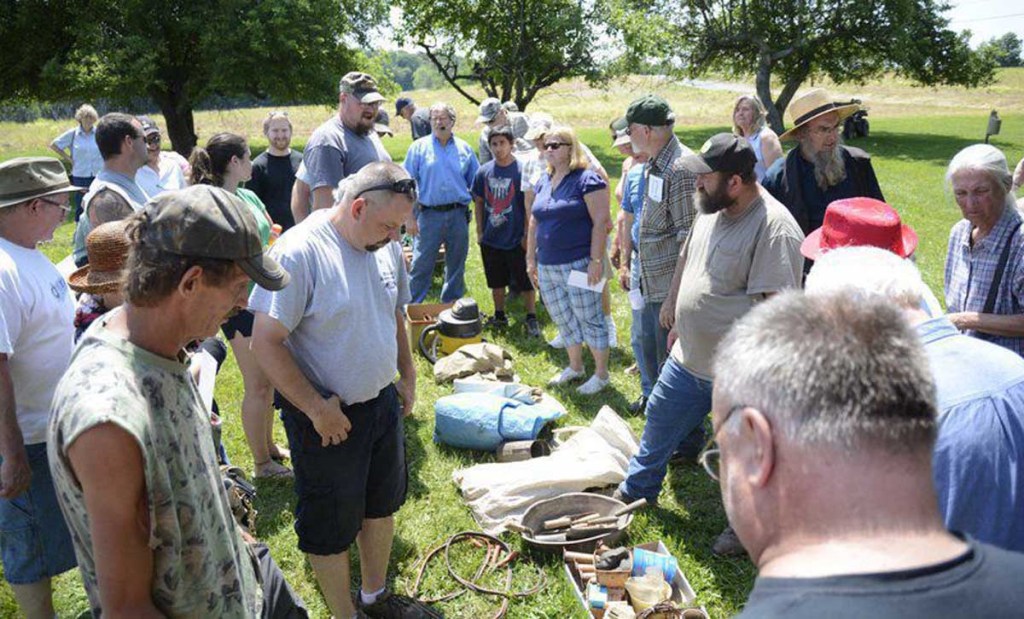Entertainment factor is critical for success in auction scene
Published 5:15 pm Wednesday, June 8, 2016

- A crowd of people look over items up for auction on Wednesday near Washingtonville, Pennsylvania.
SUNBURY, Penn. — Over his 30-plus years as an auctioneer in central Pennsylvania, Ken Hassinger said one sale in particular stands out as his most memorable — and odd.
“We sold at auction the gallows used in Snyder County. It went for $8,000,” Hassinger, of Hassinger and Courtney Auctioneers, said. “The buyer later donated it to the Snyder County Historical Society and you can see it prominently displayed at the Society today.”
That interesting item, and oddball curiosities and antiques for sale at bargain prices, is at the heart of the auctioneer’s trade.
“But it’s more than just the products. You have to present them and build excitement. You have to be an entertainer,” Hassinger said. “It’s all about inertia. Keeping everything in motion. You gotta keep people on the edge of their seats all the time.”
In years past, going to an auction was a social event, Hassinger’s partner, Neil Courtney said.
People would come early in the day, stay for lunch. It was a folksy kind of thing, Hassinger added.
“In today’s world,” Hassinger continued, “if you keep them three to four hours, you’ve done a good job. People have so many things to do. They get ants in their pants and you can only keep them for a certain amount of time.”
Old auctioneers would keep the best items for last so people would stay. But that would be a mistake today, Courtney said.
With most auctions making nearly 500 transactions, buyers want to know when their item of interest will be available to purchase.
“Today, if someone shows up and you don’t have a time set” for the merchandise they want, they’ll leave, he said. “You’d better sell it if they want it while they’re here, or you’re going to lose their money.”
Experience pays off
In the auction business you have to be able to roll with the punches. Instantaneous decisions need to be made. That’s where experience comes in handy.
Hassinger grew up on a farm and now lives on one.
“Growing up on a farm has given me an advantage in this area of knowing some of the arcane, older pieces of equipment,” Hassinger said. “I grew up with a lot of them around the house.”
Hassinger went to auctions with his grandfather and by the time he was 30, he began doing all the small auctions he could at night, learning the trade.
“I was fascinated. I learned the talk, which is called a chant. Eventually, I went to college to learn auctioneering and got a degree,” he said. Courtney apprenticed under Hassinger, and then joined him in the business.
That chant, which is a quick-cadence combination of numbers, words and sounds, is what keeps an auction moving along — and bidders entertained.
It is also the most identifiable feature of an auction.
A basic auctioneer chant goes like this:
“One dollar bid, now 2, now 2, will you give me 2?
Two dollar bid, now 3, Now 3, will you give me 3?
Three dollar bid, now 4, Now 4, will you give me 4?”
The chant is a rhythmic means of communication, a way of telling bidders what they need to know about the sale of a particular item at its time of sale. It consists of at least the current price and the asking price to outbid.
“Everybody has their own kind of take on the chant.” said Hassinger. “Even though it is the most exposed part of the business, it is such a small part of our business because there is so much going on behind the scene.”
You learn the chant as you go along as your voice adjusts and your age changes, said Courtney. “The chant changes. You have to figure the crowd. Decide what they are there for and work with them. Every crowd is different and you have to play to that crowd.”
And, because the auctioneer’s job is to sell the most amount of property or goods quickly, the chant is frequently fast.
But really, it’s just a series of numbers connected by “filler” words to give the buyer time to think between bids.
No one seems to know when or where the rhythmic chant used by most North American auctioneers originated. It probably evolved out of necessity as auctioneers saw the need to sell items in a more rapid manner. Unlike other types of sales, an auction is a one-time event where all the customers are present at the same time. So the auctioneer is responsible for selling all the items within a few hours, and the chant helps keep the items moving.
What people see scattered around on lawn, placed on tables and in boxes at the auction is just part of an auctioneer’s job. “The chanting, that’s the show business part of this,” Hassinger said. “The stuff does not just fall out of the sky.”
Once an auctioneer gains a reputation of a good salesman, people call. Sales beget sales. Auctions occur year-round, and Hassinger’s company does about 90 annually. Weekend, weekday, snow, rain, it doesn’t matter.
After the initial contact with a seller, the auctioneer will typically go to the home do an inventory, take pictures, maybe put photos of merchandise on a website to attract buyers.
Tough sell
One of the hardest things to sell in today’s world is personal property, things that people live with every day, the auctioneers say. Years ago people went to auctions to buy their first housekeeping merchandise, young people just do not participate in auctions today like they did years ago. The things you can go to a local retailer to buy are the most difficult things to sell.
Bucking that trend are Kiona and Chris Robbins, a young couple, who were out shopping at auctions for bargains that Kiona would then repurpose and resell.
“Here it is, an old flower pot,” she said. “I think that’s what it is.”
And it only cost $6.
“It’s the way I earn a little extra money,” she said.
Dave Johnson and Malcolm Derk were raised to appreciate antiques and history by relatives who got them hooked on auctions as children.
Sixty years later, Johnson, an artist now living in Ashville, N.C., is an auction aficionado who travels the East Coast looking for quality antiques and quirky items he repurposes into jewelry and other artwork.
“Between April and October, I could hit about 150 auctions,” he said.
Johnson spent the entire day under a hot sun at a recent auction rummaging through the vast collection of tools, furniture, equipment, household goods and antiques, leaving hours later with merchandise packed into his trailer.
“I bought some barn wood that I’ll sand down and make into furniture,” he said gleefully.
His sister, Christine Dewire doesn’t share his love of auctions, but joined him at the afternoon sale.
“We drove separately,” she said with a laugh, pulling out an aerosol bottle of water she used to mist her warm face.
Dewire watched in amusement as her brother darted around the property keeping his ear on the auctioneer and his eye on coveted items, like a basket filled with several small propane tanks that he purchased for $2 and will use to create jewelry. He said a similar purchase in a store would have cost 10 times as much.
“I like well-made things and history, and I like the hunt,” said the affable Johnson who particularly enjoys the social aspect of public auctions. “There are few places where you can meet and talk with people. There are a lot of personalities at auctions.”
Derk and his wife, Erin Goedegebuure, have filled their home with furniture and bric-a-brac, particularly items with local connections, they’ve picked up at auctions over the years.
Derk said his appreciation of history came from attending auctions with his father and grandfather during his childhood.
“My first purchase was a Japanese flag when I was 12,” said Derk, who likes the ease of shopping auctions. “If your looking for specific furniture, you can look at the listing and sometimes they might include photographs of the item. That’s one of the appeals. And you feel like you’re getting something of good value.”
Still, auctions can deliver surprises.
One buyer at the Geise auction bought more than he bargained for when he opened up a dresser drawer and found a live black snake coiled up inside.
“It was quite exciting,” said Dewire. “You just never know what you’ll find.”
But even auctions are keeping pace with the times.
“We have done live online auctions,” Hassinger said. “Our audience is the world. We’ll ship anywhere.”
In a few years, he believes, there won’t be fliers announcing auctions. Instead, announcements will be posted online.
Even with the modern twist, Hassinger said some things about the business will never change.
“I like the camaraderie. Meeting new and different people,” he said. “Each and every auction is a completely new experience. The beautiful thing about auctions is they are all different and you learn new things every auction you do. You find things you never found before, even if you’ve done hundreds and hundreds of auctions.”
Moore and Dandes are reporters at The Sunbury, Pennsylvania Daily Item.





